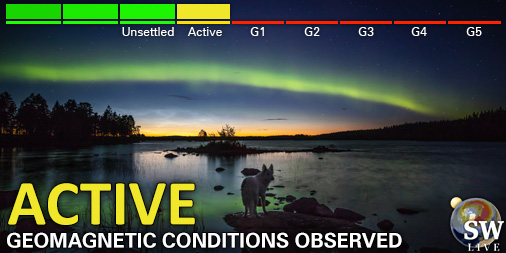Visualizzazione archivio di sabato, 5 aprile AM
Daily bulletin on solar and geomagnetic activity from the SIDC
Emesso: 2025 Apr 05 1231 UTC
SIDC Forecast
Brillamenti solari
M-class flares expected (probability >=50%)
Geomagnetism
Active conditions expected (A>=20 or K=4)
Protoni solari
Quiet
| 10cm flux | Ap | |
|---|---|---|
| 05 Apr 2025 | 180 | 041 |
| 06 Apr 2025 | 178 | 031 |
| 07 Apr 2025 | 176 | 017 |
Solar Active Regions and flaring
Solar flaring activity was low, with only C-class flares recorded over the past 24 hours. The largest flare was a C5.7 flare (SIDC Flare 4026), peaking at 23:38 UTC on April 4, associated with SIDC Sunspot Group 455 (NOAA Active Region 4043; beta), which has begun to rotate over the west limb. There are currently twelve numbered active regions visible on the solar disk. Two new active regions, SIDC Sunspot Group 468 and SIDC Sunspot Group 469, have emerged in the southeastern and northeastern quadrants, respectively. SIDC Sunspot Group 461 (NOAA Active Region 4048; beta-gamma), which remains the largest and most magnetically complex region on the disk, was growing but produced only two C-class flares over the past 24 hours. Low flaring activity was also produced by SIDC Sunspot Group 465 (NOAA Active Region 4051; beta) and SIDC Sunspot Group 466 (NOAA Active Region 4052; beta). Other regions on the disk have simple photospheric magnetic field configurations (alpha and beta) and did not show any significant flaring activity. Solar flaring activity is expected to be at low to moderate levels over the next 24 hours, with M-class flares likely and a small chance for X-class flares.
Espulsioni di massa coronale
No Earth-directed Coronal Mass Ejections (CMEs) have been detected in the available coronagraph images.
Vento solare
Over the past 24 hours, solar wind parameters (ACE and DSCOVR) remained slightly disturbed due to the arrival of a high-speed stream from a negative polarity coronal hole that began crossing the central meridian on April 1. The interplanetary magnetic field started this 24-hour period around 13 nT and then gradually decreased to values near 8 nT. The solar wind speed ranged between 500 km/s and 560 km/s. The southward component of the interplanetary magnetic field fluctuated between –11 nT and 10 nT. The magnetic field orientation was predominantly in the negative sector (field directed toward the Sun). Solar wind conditions are expected to remain slightly elevated over the next few days due to the ongoing influence of the high-speed stream.
Geomagnetism
Geomagnetic conditions reached moderate storm levels globally (Kp 6-) between 00:00 UTC and 03:00 UTC on April 5. Locally over Belgium, only minor geomagnetic storm conditions were observed (K-Bel: 5). Active conditions are expected over the next day, with a possible isolated minor storm period due to ongoing high-speed stream influence.
Proton flux levels
Over the past 24 hours the greater than 10 MeV GOES proton flux was slightly elevated, remaining well below radiation storm levels. The proton flux is expected to gradually return to nominal levels over the next day, with a small chance of exceeding minor storm levels if any high-energy flares or eruptions occur.
Electron fluxes at geostationary orbit
The greater than 2 MeV electron flux, as measured by GOES-16, was below the 1000 pfu threshold over the past 24 hours. The greater than 2 MeV electron flux, as measured by GOES-18, exceeded the 1000 pfu threshold between 17:00 UTC and 22:10 UTC on April 04. There is a chance that the greater than 2 MeV electron flux will exceed 1000 pfu threshold level in the coming days. The 24-hour electron fluence was at normal levels and is expected to remain so over the next 24 hours.
Today's estimated international sunspot number (ISN): 180, based on 15 stations.Solar indices for 04 Apr 2025
| Wolf number Catania | 210 |
| 10cm solar flux | 180 |
| AK Chambon La Forêt | 050 |
| AK Wingst | 033 |
| Estimated Ap | 036 |
| Estimated international sunspot number | 181 - Based on 29 stations |
Noticeable events summary
| Day | Begin | Max | Fine | Loc | Strength | OP | 10cm | Catania/NOAA | Radio burst types | |
|---|---|---|---|---|---|---|---|---|---|---|
| Nessuna | ||||||||||
Provided by the Solar Influences Data analysis Center© - SIDC - Processed by SpaceWeatherLive
Tutti gli orari in UTC
<< Vai alla pagina della panoramica giornaliera
I dati attuali suggeriscono ci sia una lieve possibilità perché l'aurora compaia alle seguenti regioni ad alta altitudine nel futuro prossimo
Gillam, MB, Yellowknife, NTUltime notizie
Ultimi messaggi dal forum
Supporta SpaceWeatherLive.com!
Molte persone vengono su SpaceWeatherLive per seguire l'attività del Sole o sapere se ci sia la possibilità di vedere l'aurora, ma a maggior traffico corrispondono costi maggiori. Considerate una donazione se vi piace SpaceWeatherLive così che possiamo mantenere online il sito web!

Ultimi avvisi
04:15 UTC - Attività geomagnetica
Condizioni geomagnetiche attive (Kp4) Soglia Raggiunta: 03:57 UTC
02:30 UTC - Indice di potenza emisferica
Il modello OVATION prevede che l'indice di potenza emisferica raggiunga i 50GW alle 03:23 UTC
mercoledì, 16 aprile PM
21:45 UTC - Attività geomagnetica
Tempesta geomagnetica G1 minore (Kp5) Soglia Raggiunta: 21:36 UTC
21:00 UTC - Attività geomagnetica
Tempesta geomagnetica G1 grave (Kp5) Soglia Raggiunta: 20:55 UTC
19:45 UTC - Attività geomagnetica
Tempesta geomagnetica G1 forte (Kp5) Soglia Raggiunta: 19:25 UTC
Notizie sul meteo spaziale
| Ultimo brillamento X | 2025/03/28 | X1.1 |
| Ultimo brillamento M | 2025/04/15 | M1.2 |
| Ultima tempesta geomagnetica | 2025/04/16 | Kp8- (G4) |
| Giorni senza macchie | |
|---|---|
| Ultimo giorno senza macchie | 2022/06/08 |
| Media mensile Numero di Macchie Solari | |
|---|---|
| marzo 2025 | 134.2 -20.4 |
| aprile 2025 | 120.5 -13.7 |
| Ultimi 30 giorni | 118.3 -22.1 |






